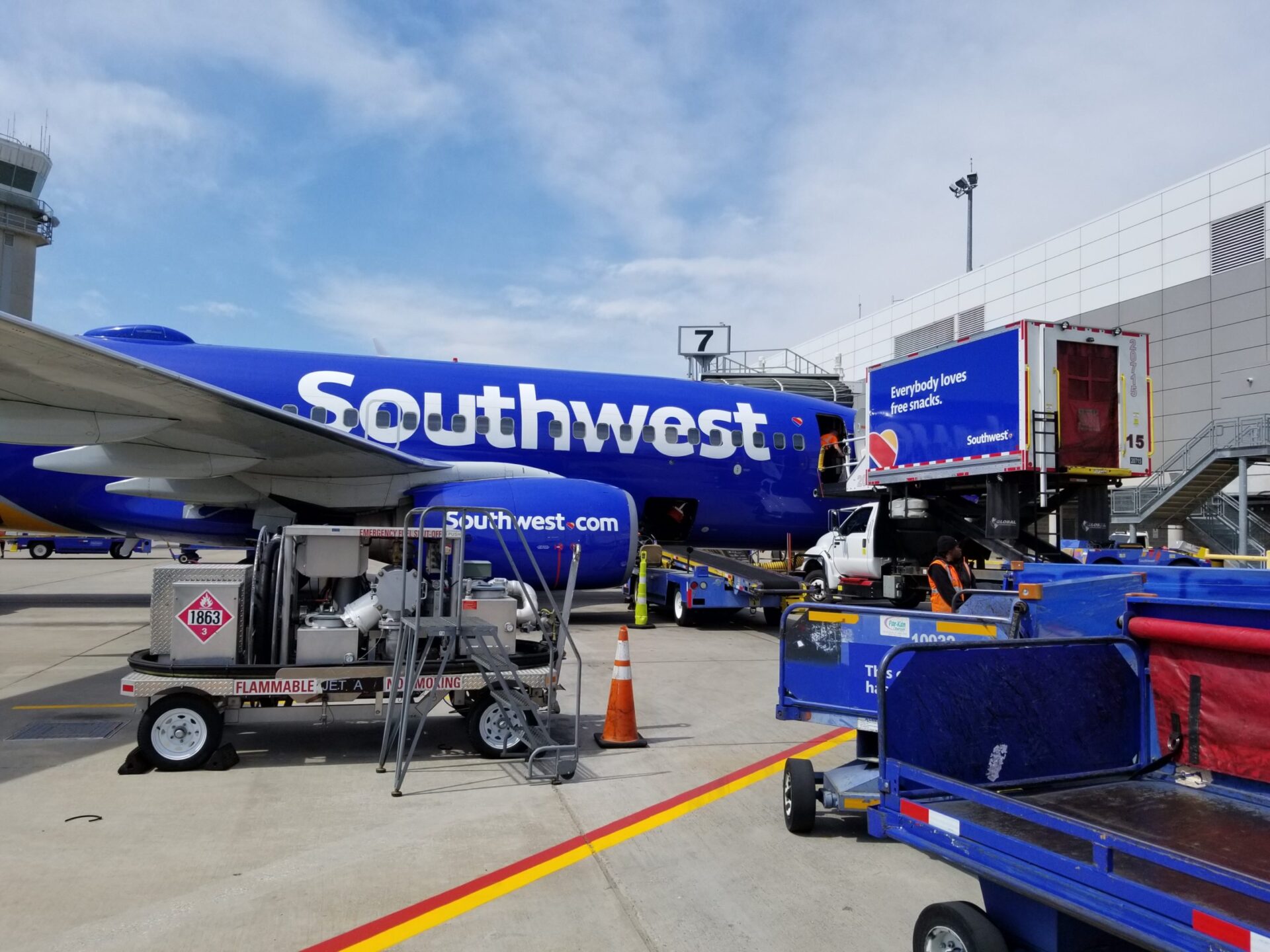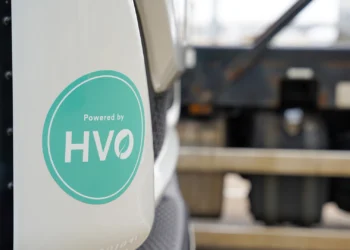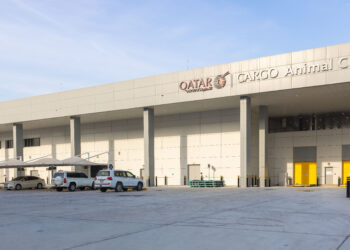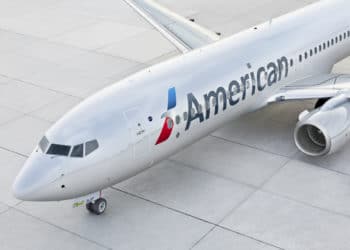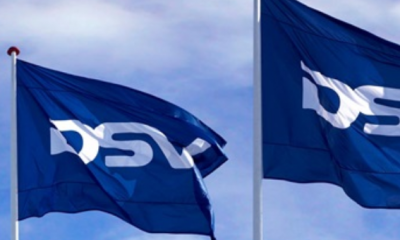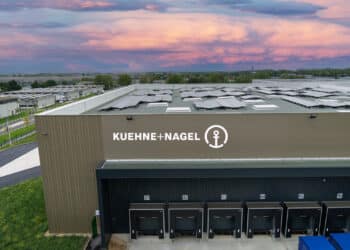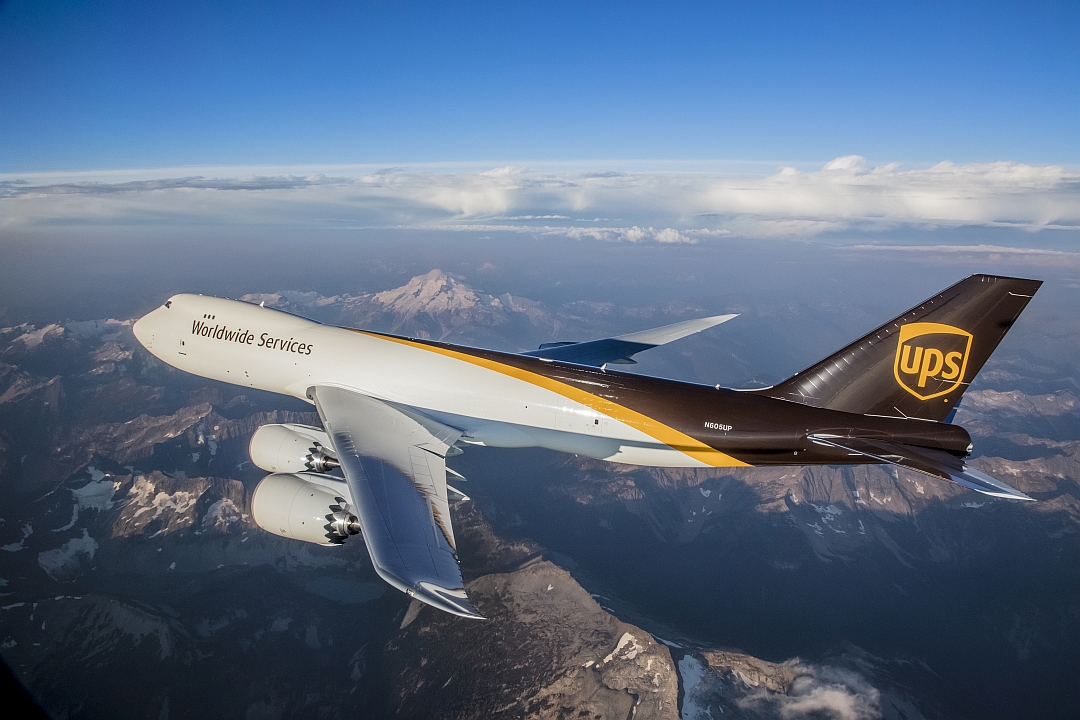No products in the cart.
Conversions: A viable solution?
The phalanx of freighters is expanding, courtesy of the arrival of a new type at the small end of the spectrum. Conversion firm Aeronautical Engineers Inc. aims to have its first MD-80 freighter on the market before the end of the month, following the converted plane’s maiden voyage in late September. Even so, Bob Convey, AEI’s vice president of sales and marketing, admits, “It is coming a little bit later than we wanted.”
The new kid on the block can lift 21.3 tonnes, with room to take 12 88-inch-by-108-inch pallets, eight 88-inch-by-125-inch pallets or eight 96-inch-by-125-inch units. This capability comes at a sticker price below $3.5 million, owing largely to the low residual value of MD-80 conversion candidates. MD-80’s exiting passenger service can be picked up for less than $1 million, while the conversion comes at about $2.5 million. This adds up to less than half the price of a converted B737-400 freighter, which has roughly the same payload capability.
The first batch of MD-80 freighters goes to Alaska-based Everts Air Cargo, followed by another U.S. client. For subsequent deliveries, AEI has contracts with clients from Central Europe, Central America, the Middle East and Africa. One interested party from Australia is looking at the aircraft to support a mining operation, Convey reveals.
He says AEI has fielded requests from all over the world, something that has surprised him. “I thought it would be more in the developing world,” Convey says. Russia and Brazil are unlikely to see MD-80 freighters soon, though, as the aircraft type never got certified in these countries for passenger operations, he explains.
The cross section of the MD-80 differs from that of the 737, which raises questions about transfers between the two types. But Convey says it doesn’t matter much at this low price tag. Still, he reveals that some prospective customers have said they would interline with wide-bodies.
The plane’s higher fuel consumption isn’t likely to have much of an impact on its appeal, he reckons. For one thing, the MD-80’s lower acquisition cost gives operators leeway to spend a little more on fuel. Moreover, Convey estimates that utilization will be around two to four hours a day. “If it were 12 hours a day, it would be a different story,” he says. So far, AEI has netted 15 firm orders for the MD-80SFs, which should keep its conversion lines busy for some time.
Turning an MD-80 into an all-cargo configuration takes 60 to 70 days, Convey says, describing it as a sturdy plane that converts relatively easily. With many MD-80s still in passenger service, he expects no bottlenecks in feedstock for years to come. “A bigger problem will be slot availability,” he says.
Originally, AEI wasn’t planning to extend the conversion program to the MD-90, but management has since decided to convert this model as well. “The MD-90 freighter will have one more position, and it has greater range. I think it will do well in Europe,” Convey says.
The tally of MD-80 orders so far puts the new freighter level with AEI’s backlog of 737-400 conversions. With 11 pallet positions, the -400 has emerged as the dominant conversion candidate in the 737 family, and demand has been robust this year. “We are looking at buying another facility,” Convey says. AEI expects to perform 13 737 conversions in the coming year.
The lively activity in the narrow-body segment is in stark contrast to the current state of conversion projects for large wide-body aircraft. “We see a slowdown in conversions done by Boeing and others,” notes Chris Damianos, executive vice president, specialty markets and head of cargo programs and regional jets, GE Commercial Aviation Services. “We don’t have anything in conversion right now and nothing committed to conversion.”
Dan da Silva, vice president for freighter conversions at Boeing, confirms Damianos’ sentiments. He reveals that Boeing has only performed three 747-400 conversions this year: two for Thai Airways and one for Evergreen International Airlines. “The market has been quite challenging since 2008,” da Silva says. “And we have also been victims of the success of the 777 [freighter] and the 747-8.”
As carriers took freighters out of the market in response to soaring costs and slumping yields, their efforts to find buyers or lessors for some of these planes have flooded the market with large freighters. Simply put, Air Atlanta Icelandic’s Baldvin Hermannsson says, there’s currently an influx of BCFs in the market. “It is a buyer’s market for BCFs right now,” he adds.
“We are not taking feedstock and converting ourselves,” Hermannsson says. “I don’t see anybody doing that anytime soon.” After all, he asks, “Why would you invest $12 to $18 million in converting an aircraft if you have a lot of 747-400s and -400BCFs available?” He adds that prices for -400BCFs have been adjusting to the new situation.
It hasn’t helped that new, large wide-body freighters are entering this depressed market. Earlier this year, GECAS took delivery of a new 777 freighter. “Now, we grow mostly through new freighters,” Damianos says. “In the past, it was from conversions.”
Some insiders believe that this could very well morph into a long-term trend. While Boeing’s latest freighter forecast predicts that the share of large, wide-body cargo planes will boost their share of the global fleet from currently 31 percent to 36 percent, conversions are not going to be the dominant segment in this group — unlike in the mid-sized and narrow-body freighter segments, where they will constitute the lion’s share of the planes.
Recent large, wide-body deliveries have hurt conversions doubly hard. Not only have they added to the glut in freighter capacity, they have also freed up 747-400s. Faced with lackluster demand and unsustainable yields, carriers that take delivery of 747-8s tend to replace 747-400 freighters with them, rather than boost their lineup with one more large freighter. This has pushed a number of 747-400Fs and -400BCFs into the market, undermining the case for conversions.
“This creates a secondary market that puts a damper on conversions,” Boeing’s da Silva says.
In the present slow market, the rise in belly capacity on new wide-body passenger craft — such as Boeing 777s and 787s, as well as the Airbus A350 down the road — have further eroded the case for freighters. According to Boeing’s da Silva, the phenomenon has been blown out of proportion, though.
“The actual belly volume available for cargo has an effect, but it is a shift of a few percentage points, rather than a fundamental shift in cargo transportation,” he says.
Boeing’s 20-year forecast, which appeared in Air Cargo World’s October issue, actually projects a slight gain for freighters in overall market share over the period, da Silva points out. He also refutes the argument that financing for freighter conversions is in grave danger of drying up, a warning some executives sounded this year.
“There are plenty of plane-financing instruments out there,” da Silva says. “Capital availability is an issue, but not to convert planes into freighters. It’s an issue when it comes to the financing of older airplanes.”
Conversion outfits have been trying to hold the line on their pricing, but under the relentless pressure in the market, they have found it increasingly hard to do so, Hermannsson observes. GECAS’ Damianos doesn’t think that lower conversion rates would stimulate activity seriously, though. “The lack of demand for conversions is not driven by the conversion price tag but by the market situation,” he says.
It could be argued that low price tags make for good opportunities to build up capacity in preparation for a return to growth, but GECAS is not following this logic. “Maybe now is the time to move,” Damianos says. “There will be a recovery.”
He says it’s a question of timing. “We will probably sit on the sidelines for a bit until we see when the recovery takes hold,” he maintains. Da Silva, however, isn’t holding his breath for a fast recovery. “I expect this market to stay slow for the next 18-plus months,” he says.
Despite the market conditions, Boeing is getting ready for another freighter conversion program, in the bracket below the 747. The company has registered enough of an uptick in conversations about and RFPs for 767 freighters that it decided to fire up a 767 conversion line.
“The 767 has established itself as the preferred mid-sized freighter,” da Silva says. “FedEx, UPS and DHL have all chosen it as the base model for their mid-size fleets. That’s the biggest market for mid-sized freighters.”
What everybody has been waiting for is the proliferation of new passenger planes that can replace the 767, notably the 787. The lengthy delays in the 787’s development caused passenger airlines to hold on longer than expected to their 767-300ERs, but now they are beginning to exit passenger service and become available for conversion.
“With the growing availability of 767-300ERs, we are going to see the price come down,” da Silva predicts. At this point, too few 767-300ERs have come on the market to determine a clear residual value on the model. Da Silva reckons that a 15-year-old plane should start below $15 million. With $16 million to be spent on conversion and maintenance work, a remodeled freighter should be under $30 million, he says.
Damianos sees good potential for the 767-300ER, pointing to a large, global user base. GECAS has a number of 767-300s in passenger service, which it may convert into all-cargo configuration, but such a move is a long way off, he says.
Air Atlanta Icelandic intends to looks closely into the twin-engine, wide-body segment in the near future, but the 767 is not on its radar. After all, Hermannsson says, the company’s clientele hasn’t shown any demand for a 767 freighter.
“We will be looking at the 777, the 777 conversion — if and when it emerges,” he says. “The A330 would also be a possibility — either a production freighter or a conversion, but not right now. At the moment, it’s too expensive. You can’t get the hours you need to sustain it.”
Boeing has been plodding along with preparation work for a 777 conversion program. The load and stress analysis has been completed, and the next step will be to step into the market and start promoting the concept, da Silva says. He figures that 2013-2014 will be the sweet spot to launch a conversion program, which would put deliveries to commence in the 2015-2017 timeframe.
“Then feedstock will start to pop up,” he says. “By mid-decade, people will start to release their 777s.” At this point, Boeing is in the middle of determining the pricing of the conversion. It will be more complex than turning a 747 into an all-cargo configuration, da Silva says. The 777-200ER is optimized for passenger operation and will require extensive structural modification for significant gains, he says.
Damianos thinks that a converted 777-200ER will make an attractive option down the road, but he does not see feedstock becoming readily available. “It is enormously popular with passenger operators. There is no reason to believe we are going to see a lot of these on the market,” he says. “They will stay in passenger service.”
The phalanx of freighters is expanding, courtesy of the arrival of a new type at the small end of the spectrum. Conversion firm Aeronautical Engineers Inc. aims to have its first MD-80 freighter on the market before the end of the month, following the converted plane’s maiden voyage in late September. Even so, Bob Convey, AEI’s vice president of sales and marketing, admits, “It is coming a little bit later than we wanted.”
The new kid on the block can lift 21.3 tonnes, with room to take 12 88-inch-by-108-inch pallets, eight 88-inch-by-125-inch pallets or eight 96-inch-by-125-inch units. This capability comes at a sticker price below $3.5 million, owing largely to the low residual value of MD-80 conversion candidates. MD-80’s exiting passenger service can be picked up for less than $1 million, while the conversion comes at about $2.5 million. This adds up to less than half the price of a converted B737-400 freighter, which has roughly the same payload capability.
The first batch of MD-80 freighters goes to Alaska-based Everts Air Cargo, followed by another U.S. client. For subsequent deliveries, AEI has contracts with clients from Central Europe, Central America, the Middle East and Africa. One interested party from Australia is looking at the aircraft to support a mining operation, Convey reveals.
He says AEI has fielded requests from all over the world, something that has surprised him. “I thought it would be more in the developing world,” Convey says. Russia and Brazil are unlikely to see MD-80 freighters soon, though, as the aircraft type never got certified in these countries for passenger operations, he explains.
The cross section of the MD-80 differs from that of the 737, which raises questions about transfers between the two types. But Convey says it doesn’t matter much at this low price tag. Still, he reveals that some prospective customers have said they would interline with wide-bodies.
The plane’s higher fuel consumption isn’t likely to have much of an impact on its appeal, he reckons. For one thing, the MD-80’s lower acquisition cost gives operators leeway to spend a little more on fuel. Moreover, Convey estimates that utilization will be around two to four hours a day. “If it were 12 hours a day, it would be a different story,” he says. So far, AEI has netted 15 firm orders for the MD-80SFs, which should keep its conversion lines busy for some time.
Turning an MD-80 into an all-cargo configuration takes 60 to 70 days, Convey says, describing it as a sturdy plane that converts relatively easily. With many MD-80s still in passenger service, he expects no bottlenecks in feedstock for years to come. “A bigger problem will be slot availability,” he says.
Originally, AEI wasn’t planning to extend the conversion program to the MD-90, but management has since decided to convert this model as well. “The MD-90 freighter will have one more position, and it has greater range. I think it will do well in Europe,” Convey says.
The tally of MD-80 orders so far puts the new freighter level with AEI’s backlog of 737-400 conversions. With 11 pallet positions, the -400 has emerged as the dominant conversion candidate in the 737 family, and demand has been robust this year. “We are looking at buying another facility,” Convey says. AEI expects to perform 13 737 conversions in the coming year.
The lively activity in the narrow-body segment is in stark contrast to the current state of conversion projects for large wide-body aircraft. “We see a slowdown in conversions done by Boeing and others,” notes Chris Damianos, executive vice president, specialty markets and head of cargo programs and regional jets, GE Commercial Aviation Services. “We don’t have anything in conversion right now and nothing committed to conversion.”
Dan da Silva, vice president for freighter conversions at Boeing, confirms Damianos’ sentiments. He reveals that Boeing has only performed three 747-400 conversions this year: two for Thai Airways and one for Evergreen International Airlines. “The market has been quite challenging since 2008,” da Silva says. “And we have also been victims of the success of the 777 [freighter] and the 747-8.”
As carriers took freighters out of the market in response to soaring costs and slumping yields, their efforts to find buyers or lessors for some of these planes have flooded the market with large freighters. Simply put, Air Atlanta Icelandic’s Baldvin Hermannsson says, there’s currently an influx of BCFs in the market. “It is a buyer’s market for BCFs right now,” he adds.
“We are not taking feedstock and converting ourselves,” Hermannsson says. “I don’t see anybody doing that anytime soon.” After all, he asks, “Why would you invest $12 to $18 million in converting an aircraft if you have a lot of 747-400s and -400BCFs available?” He adds that prices for -400BCFs have been adjusting to the new situation.
It hasn’t helped that new, large wide-body freighters are entering this depressed market. Earlier this year, GECAS took delivery of a new 777 freighter. “Now, we grow mostly through new freighters,” Damianos says. “In the past, it was from conversions.”
Some insiders believe that this could very well morph into a long-term trend. While Boeing’s latest freighter forecast predicts that the share of large, wide-body cargo planes will boost their share of the global fleet from currently 31 percent to 36 percent, conversions are not going to be the dominant segment in this group — unlike in the mid-sized and narrow-body freighter segments, where they will constitute the lion’s share of the planes.
Recent large, wide-body deliveries have hurt conversions doubly hard. Not only have they added to the glut in freighter capacity, they have also freed up 747-400s. Faced with lackluster demand and unsustainable yields, carriers that take delivery of 747-8s tend to replace 747-400 freighters with them, rather than boost their lineup with one more large freighter. This has pushed a number of 747-400Fs and -400BCFs into the market, undermining the case for conversions.
“This creates a secondary market that puts a damper on conversions,” Boeing’s da Silva says.
In the present slow market, the rise in belly capacity on new wide-body passenger craft — such as Boeing 777s and 787s, as well as the Airbus A350 down the road — have further eroded the case for freighters. According to Boeing’s da Silva, the phenomenon has been blown out of proportion, though.
“The actual belly volume available for cargo has an effect, but it is a shift of a few percentage points, rather than a fundamental shift in cargo transportation,” he says.
Boeing’s 20-year forecast, which appeared in Air Cargo World’s October issue, actually projects a slight gain for freighters in overall market share over the period, da Silva points out. He also refutes the argument that financing for freighter conversions is in grave danger of drying up, a warning some executives sounded this year.
“There are plenty of plane-financing instruments out there,” da Silva says. “Capital availability is an issue, but not to convert planes into freighters. It’s an issue when it comes to the financing of older airplanes.”
Conversion outfits have been trying to hold the line on their pricing, but under the relentless pressure in the market, they have found it increasingly hard to do so, Hermannsson observes. GECAS’ Damianos doesn’t think that lower conversion rates would stimulate activity seriously, though. “The lack of demand for conversions is not driven by the conversion price tag but by the market situation,” he says.
It could be argued that low price tags make for good opportunities to build up capacity in preparation for a return to growth, but GECAS is not following this logic. “Maybe now is the time to move,” Damianos says. “There will be a recovery.”
He says it’s a question of timing. “We will probably sit on the sidelines for a bit until we see when the recovery takes hold,” he maintains. Da Silva, however, isn’t holding his breath for a fast recovery. “I expect this market to stay slow for the next 18-plus months,” he says.
Despite the market conditions, Boeing is getting ready for another freighter conversion program, in the bracket below the 747. The company has registered enough of an uptick in conversations about and RFPs for 767 freighters that it decided to fire up a 767 conversion line.
“The 767 has established itself as the preferred mid-sized freighter,” da Silva says. “FedEx, UPS and DHL have all chosen it as the base model for their mid-size fleets. That’s the biggest market for mid-sized freighters.”
What everybody has been waiting for is the proliferation of new passenger planes that can replace the 767, notably the 787. The lengthy delays in the 787’s development caused passenger airlines to hold on longer than expected to their 767-300ERs, but now they are beginning to exit passenger service and become available for conversion.
“With the growing availability of 767-300ERs, we are going to see the price come down,” da Silva predicts. At this point, too few 767-300ERs have come on the market to determine a clear residual value on the model. Da Silva reckons that a 15-year-old plane should start below $15 million. With $16 million to be spent on conversion and maintenance work, a remodeled freighter should be under $30 million, he says.
Damianos sees good potential for the 767-300ER, pointing to a large, global user base. GECAS has a number of 767-300s in passenger service, which it may convert into all-cargo configuration, but such a move is a long way off, he says.
Air Atlanta Icelandic intends to looks closely into the twin-engine, wide-body segment in the near future, but the 767 is not on its radar. After all, Hermannsson says, the company’s clientele hasn’t shown any demand for a 767 freighter.
“We will be looking at the 777, the 777 conversion — if and when it emerges,” he says. “The A330 would also be a possibility — either a production freighter or a conversion, but not right now. At the moment, it’s too expensive. You can’t get the hours you need to sustain it.”
Boeing has been plodding along with preparation work for a 777 conversion program. The load and stress analysis has been completed, and the next step will be to step into the market and start promoting the concept, da Silva says. He figures that 2013-2014 will be the sweet spot to launch a conversion program, which would put deliveries to commence in the 2015-2017 timeframe.
“Then feedstock will start to pop up,” he says. “By mid-decade, people will start to release their 777s.” At this point, Boeing is in the middle of determining the pricing of the conversion. It will be more complex than turning a 747 into an all-cargo configuration, da Silva says. The 777-200ER is optimized for passenger operation and will require extensive structural modification for significant gains, he says.
Damianos thinks that a converted 777-200ER will make an attractive option down the road, but he does not see feedstock becoming readily available. “It is enormously popular with passenger operators. There is no reason to believe we are going to see a lot of these on the market,” he says. “They will stay in passenger service.”


